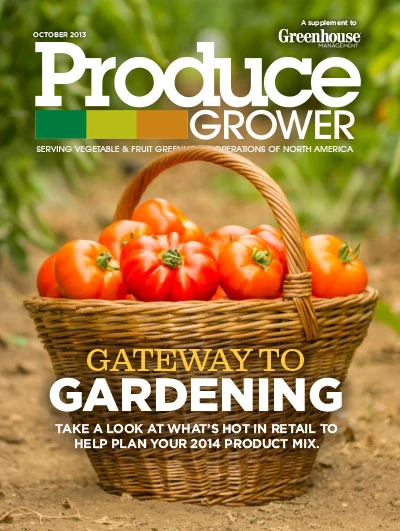 Whether growing them as transplants for retail, or as a finished fruit, Vegetalis’ bell peppers Mohawk and Redskin are sure winners for growers.
Whether growing them as transplants for retail, or as a finished fruit, Vegetalis’ bell peppers Mohawk and Redskin are sure winners for growers.
Mohawk and Redskin bell peppers grow 12 inches tall with a spread of 20 inches. From transplant, these varieties mature in 75-80 days.
Plug production
Stage 1: 5-7 days - Radicle emergence
- Use a well-drained, disease-free, peat based plug media with pH 5.8-6.2, EC <0.75mS/cm.
- Cover seed with vermiculite.
- Keep media uniformly moist, media temperature should be 71-78°F and air temperature 60-70°F.
- Light not necessary for germination.
Stage 2: 7-10 days - Stem and cotyledon emergence
- Maintain media temperature to 68-73°F and air temperature 60-70°F.
- Allow medium to dry out slightly prior to watering.
- Maintain light levels 1,500-2,500 f.c.
- Fertilizer 14-0-14 (Rate 50-100ppm) every other watering.
Stage 3: 10-14 days - True leaf growth
- Maintain soil temperature to 65-70°F and air temperature 60-70°F.
- Allow medium to dry out slightly prior to watering to avoid wilt.
- Maintain light levels 1,500-2,500 f.c.
- Fertilizer 14-0-14 (Rate 100-175ppm) every 2nd-3rd watering.
 Stage 4: 7 days - To transplant stage or shipping
Stage 4: 7 days - To transplant stage or shipping
- Maintain soil temperature to 62-67°F and air temperature 58-65°F.
- Allow medium to dry out slightly prior to watering to avoid wilt.
- Ensure you maintain pH at 5.5 to 6.2 and EC <0.75mS/cm.
- Maintain light levels up to 5,000 f.c. Fertilizer 14-0-14 or 15-5-15 (Rate 100-175ppm) every 2nd-3rd watering.
Growing on to finish
- Well-drained, disease free mix with pH 5.5-6.2 and EC <0.75 mS/cm.
- Keep medium uniformly moist, and media temperatures at 68-79°F during the day and 65-70°F at night.
- Maintain light levels at 4,000-5,000 f.c. or as high as possible.
- Use fertilizer 20-10-20 (Rate 175-225ppm) every other watering.
- The use of chemical growth regulators are not recommended on pepper plants. Growth can be effectively controlled by high light levels and spacing of plants.
Sponsored Content From loose plugs to prefilled trays and textiles, our TruRoot® propagation line, featuring QuickPlug Technology, is the optimum way to accelerate germination and improve root development. Trusted across the horticulture industry, TruRoot is the key to better propagation from food crops to florals. Sponsored Content From loose plugs to prefilled trays and textiles, our TruRoot® propagation line, featuring QuickPlug Technology, is the optimum way to accelerate germination and improve root development. Trusted across the horticulture industry, TruRoot is the key to better propagation from food crops to florals. Sponsored Content From loose plugs to prefilled trays and textiles, our TruRoot® propagation line, featuring QuickPlug Technology, is the optimum way to accelerate germination and improve root development. Trusted across the horticulture industry, TruRoot is the key to better propagation from food crops to florals. Sponsored Content From loose plugs to prefilled trays and textiles, our TruRoot® propagation line, featuring QuickPlug Technology, is the optimum way to accelerate germination and improve root development. Trusted across the horticulture industry, TruRoot is the key to better propagation from food crops to florals. Sponsored Content From loose plugs to prefilled trays and textiles, our TruRoot® propagation line, featuring QuickPlug Technology, is the optimum way to accelerate germination and improve root development. Trusted across the horticulture industry, TruRoot is the key to better propagation from food crops to florals. Sponsored Content From loose plugs to prefilled trays and textiles, our TruRoot® propagation line, featuring QuickPlug Technology, is the optimum way to accelerate germination and improve root development. Trusted across the horticulture industry, TruRoot is the key to better propagation from food crops to florals.A Better Start for Plants
A Better Start for Plants
A Better Start for Plants
A Better Start for Plants
A Better Start for Plants
A Better Start for Plants
One cup of raw bell peppers provides 195.8 percent daily value of vitamin C.
Photos courtesy of Vegetalis
Get curated news on YOUR industry.
Enter your email to receive our newsletters.
Explore the October 2013 Issue
Check out more from this issue and find your next story to read.
Latest from Produce Grower
- The Growth Industry Episode 3: Across the Pond with Neville Stein
- PG CEA HERB Part 2: Analyzing basil nutrient disorders
- University of Evansville launches 'We Grow Aces!' to tackle food insecurity with anu, eko Solutions
- LettUs Grow, KG Systems partner on Advanced Aeroponics technology
- Find out what's in FMI's Power of Produce 2025 report
- The Growth Industry Episode 2: Emily Showalter on how Willoway Nurseries transformed its business
- 80 Acres Farms expands to Georgia, Texas and Colorado
- How BrightFarms quadrupled capacity in six months







